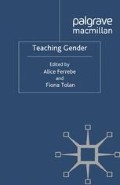Abstract
While much of this volume addresses the role of gender in English HE, this chapter considers the practice of teaching contemporary fiction in an environment where students have a reasonable understanding of gender and are favourably disposed towards feminist theory, but do not always see the value of ‘English’. I assess two pedagogical relationships between gender and ‘English’: (1) the resistance to fiction by some gender students and (2) the value of teaching the new field of digital fiction. By reflecting on these two significant challenges to English Studies I identify particularly feminist interactions between ‘English’ and ‘gender’, connections that I hope will be of use to teachers in both areas. My own field is contemporary literature and culture, and I teach at the Centre for Women’s Studies at the University of York, a postgraduate unit offering interdisciplinary degrees within humanities and social science.1
Access this chapter
Tax calculation will be finalised at checkout
Purchases are for personal use only
Preview
Unable to display preview. Download preview PDF.
Works Cited
Alcott, Louisa M. (1868/1869) Little Women (Boston, MA: Roberts Brothers).
Bal, Miekle (2002) Travelling Concepts in the Humanities: A Rough Guide ( Toronto: University of Toronto Press).
Barthes, Roland (1970/1974) S/Z, trans. R. Miller (New York: Hill and Wang).
Butler, Judith (1990) Gender Trouble: Feminism and the Subversion of Identity ( London and New York: Routledge).
Braidotti, Rosi (n.d.), Rosi (n.d.) ‘Cyberfeminism with a Difference’ http://www.let.uu.nl/womens_studies/rosi/cyberfem.htm, accessed 23 September 2010.
De Beauvoir, Simone (1953), The Second Sex, trans. and ed. H.M. Parshley ( New York: Knopf).
Eagleton, Mary (1986) Feminist Literary Theory: A Reader ( Oxford: Basil Blackwell).
Ensslin, Astrid (2007), Section on Patchwork Girl extracted by johnvinder (2010) from Canonizing Hypertext (London: Continuum), 78–81 http://eld.eliterature.org/node/323, accessed 23 September 2010.
Fairbairns, Zoe (1979) Benefits ( London: Virago).
Greer, Germaine (1970) The Female Eunuch ( London: Paladin).
Guertin, Carolyn and Marjorie Coverley Luesebrink (February 2000), curators, Carolyn and Marjorie Coverley Luesebrink (February 2000), curators ‘The Progressive Dinner Party’, Riding the Meridian http://www.heelstone.com/meridian/templates/Dinner/dinner1.htm, accessed 23 September 2010.
Guertin, Carolyn (1999–2005) Assemblage: the Women’s New Media Gallery (University of Toronto, Canada, and Trace Online Writing Centre) http://tracearchive.ntu.ac.uk/traced/guertin/assemblage.htm, accessed 23 September 2010.
Hayles, N. Katherine (2000) ‘Flickering Connectivities in Shelley Jackson’s Patchwork Girl: The Importance of Media-Specific Analysis ’ http://pmc.iath.virginia.edu/text-only/issue.100/10.2hayles.txt, accessed 23 September 2010.
Hayles, N. Katherine (2008) Electronic Literature: New Horizons for the Literary ( Notre Dame, IN: Notre Dame University Press).
Hayles, N. Katherine and Nick Montfort, Scott Rettberg and Stephanie Strickland, eds (2006) Electronic Literature Collection Vol. 1 http://www.eliterature.org/collection/1, accessed 23 September 2010.
Hayles, N. Katherine (1985/1991) ‘A Cyborg Manifesto: Science, Technology, and Socialist-Feminism in the Late Twentieth Century,’ Simians, Cyborgs and Women: The Reinvention of Nature (London and New York: Routledge), 149–81.
Haraway, Donna (1988) ‘Situated Knowledge’, Feminist Studies 14 (3): 575–99.
Hennegan, Alison (1998)‘On Becoming a Lesbian Reader’, Sweet Dreams: Sexuality, Gender and Popular Fiction, ed. Susannah Radstone (London: Lawrence & Wishart), 165–90.
Hooks, Bell (1994) Teaching to Transgress: Education as the Practice of Freedom ( London and New York: Routledge).
Jackson, Shelley (1995) Patchwork Girl ( Watertown, MA: Eastgate).
Joyce, Michael (1990) Afternoon, a Story ( Watertown, MA: Eastgate).
March, Caeia (1986) Three Ply Yarn ( London: The Women’s Press).
Millett, Kate (1970) Sexual Politics ( New York: Doubleday).
Moi, Toril (1985) Sexual/Textual Politics: Feminist Literary Theory ( London and New York: Methuen).
Moi, Toril (2001) What Is a Woman? And Other Essays ( Oxford: Oxford University Press).
Murray, Janet H. (1998) Hamlet on the Holodeck: The Future of Narrative in Cyberspace ( Cambridge, MA: MIT Press).
Pearce, Lynne (1995) ‘Finding a Place from Which to Write: The Methodology of Feminist Textual Practice’, Feminist Cultural Theory: Process and Production, ed. Beverley Skeggs ( Manchester: Manchester University Press).
Piercy, Marge (1976) Woman on the Edge of Time ( New York: Knopf).
Showalter, Elaine (1986) The New Feminist Criticism: Essays on Women, Literature and Theory ( London: Virago).
Sundén, Jenny (2008) ‘What if Frankenstein(’s Monster) Was a Girl? Reproduction and Subjectivity in the Digital Age’, Bits of Life: Feminism at the Intersections ofMedia, Bioscience, and Technology, eds Anneke Smelik and Nina Lykke, ( Seattle, WA: University of Washington Press).
Thomas, Sue (2004) Hello World: Travels in Virtuality ( York: Raw Nerve Books).
Warhol, Robyn R., and Diane Price Herndl (1991) Feminisms: An Anthology of Literary Theory and Criticism ( Piscataway, NJ: Rutgers University Press).
Winterson, Jeanette (1985) Oranges Are Not the Only Fruit ( London and Boston: Pandora).
Editor information
Editors and Affiliations
Copyright information
© 2012 Ann Kaloski Naylor
About this chapter
Cite this chapter
Naylor, A.K. (2012). Teaching English to Gender Students: Collaborative Encounters with Print and Digital Texts. In: Ferrebe, A., Tolan, F. (eds) Teaching Gender. Teaching the New English. Palgrave Macmillan, London. https://doi.org/10.1057/9780230360778_3
Download citation
DOI: https://doi.org/10.1057/9780230360778_3
Publisher Name: Palgrave Macmillan, London
Print ISBN: 978-0-230-25252-3
Online ISBN: 978-0-230-36077-8
eBook Packages: Palgrave Literature CollectionLiterature, Cultural and Media Studies (R0)

